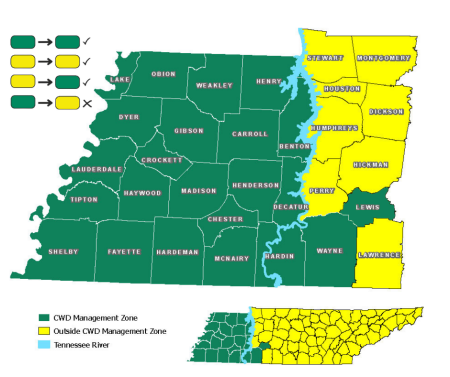
CWD Management Zone for Carcass Transportation & Wildlife Feeding Regulations
Carcass Transportation Restrictions
Deer carcass transportation and wildlife feeding restrictions apply to the CWD Management Zone. These restrictions have been put in place to reduce the spread of Chronic Wasting Disease. Carcass transport restrictions reduce the chance that an infected deer carcass becomes a source of infection in a new area. Wildlife feeding restrictions reduce deer exposure to potential infections in other deer and in the environments where deer unnaturally congregate due to supplemental feeding.
The CWD Management Zone includes Benton, Carroll, Chester, Crockett, Decatur, Dyer, Fayette, Gibson, Hardeman, Hardin, Haywood, Henderson, Henry, Madison, McNairy, Lake, Lauderdale, Lewis, Obion, Shelby, Tipton, Wayne, and Weakley Counties.
- Deer carcasses can be moved within and between counties in the CWD Management Zone.
- Once a carcass is brought into the CWD Management Zone, it cannot be moved out of the zone.
- Approved parts (listed below) are free to be transported anywhere statewide.
- Also remember, only approved parts can be transported into Tennessee from another state.
Downloadable CWD Management Zone: Carcass Transport and Feeding Restrictions Flyer for dissemination.
Approved Parts
These parts have a low risk of spreading CWD.
- Deboned meat
- Antlers, antlers attached to cleaned skull plates, cleaned skulls (where no meat or tissues are attached to the skull)
- Cleaned teeth
- Finished taxidermy and antler products
- Hides and tanned products
Examples of Unapproved Parts
These parts have high risk of spreading CWD.
- Whole and field-dressed carcasses
- Organs
- Guts
- Uncleaned (meat and/or tissue are present) heads/skulls/skull caps
- Non-muscle tissues
Wildlife Feeding Restrictions
Within the CWD Management Zone the placement of grain, salt products, minerals, and other consumable natural and manufactured products is prohibited.
Feeding restrictions do not apply if the feed or minerals are:
- placed within one hundred (100) feet of any residence or occupied building; or
- placed in such a manner to reasonably exclude access by deer; or
- placed as part of a wild hog management effort authorized by the agency; or
- present from normal agricultural practices, normal forest management practices, or crop and wildlife food production practices.
Statewide Carcass Importation Restrictions
If you harvest a deer, elk, or moose from anywhere outside the state, it must be properly processed before bringing it into the state of Tennessee.
No person may import, transport, or possess in Tennessee a cervid carcass or carcass part from anywhere outside state except as provided herein:
(a) Meat that has bones removed
(b) Antlers, antlers attached to cleaned skull plates, or cleaned skulls (where no meat or tissues are attached to the skull.)
(c) Cleaned teeth
(d) Finished taxidermy and antler products
(e) Hides (tanned or green) and tanned products
Best Practices for Carcass Disposal
Deer carcass and carcass parts from infected deer pose a significant threat to preventing the spread of CWD. If not managed appropriately, carcasses of CWD-infected deer can pass the infectious material (prions) into the environment, which can then infect other deer. CWD is not known to affect humans, pets, or livestock.
As such, TWRA recommends the following best practices for disposal of unused deer parts, including gut material from field dressing a deer:
- Leave unused parts at harvest location. Bury the parts to further minimize possible spread.
- Bag in contractor-grade 3mm thick garbage bag(s) and dispose of in a landfill
- Use a meat processor for disposal




